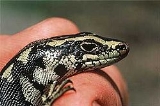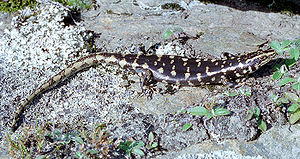
Otago skink
Encyclopedia
The Otago skink, Oligosoma otagense, is an endangered species
of large skink
of the family
Scincidae, found in the central Otago
region of New Zealand
.
in their rocky habitat of lichen
-covered rocks and schist
outcrops. Like most skinks, Otago skinks are omnivore
s and feed on a wide variety of insect
s and fleshy fruit
s. They are long lived (up to 15 years), slow to mature (3 to 4 years), and give birth to 3 or 4 live and independent young in January to March each year.
 Otago skinks are only found in very specific locations in Otago
Otago skinks are only found in very specific locations in Otago
, and are typically limited to the large schist rock outcroppings found in that region. They can often be seen sunning themselves on these rocks and seek refuge in the deep crevices when alarmed, at night and on cold days. As of 2000, the range of the Otago skink has decreased by roughly 90% when compared to the estimated historic range. Although it was once widespread, land use change, particularly the intensification of farming, and the introduction of mammalian predators has led to a decline in the population. The New Zealand Department of Conservation
(DOC) estimates that there are only 2,000 - 5,000 individual Otago skinks remaining and recent work suggests that the skinks are still in decline. Work to identify the causes of decline is ongoing, as are protection efforts through habitat protection, predator-proof fencing and predator control.
Endangered species
An endangered species is a population of organisms which is at risk of becoming extinct because it is either few in numbers, or threatened by changing environmental or predation parameters...
of large skink
Skink
Skinks are lizards belonging to the family Scincidae. Together with several other lizard families, including Lacertidae , they comprise the superfamily or infraorder Scincomorpha...
of the family
Family (biology)
In biological classification, family is* a taxonomic rank. Other well-known ranks are life, domain, kingdom, phylum, class, order, genus, and species, with family fitting between order and genus. As for the other well-known ranks, there is the option of an immediately lower rank, indicated by the...
Scincidae, found in the central Otago
Otago
Otago is a region of New Zealand in the south of the South Island. The region covers an area of approximately making it the country's second largest region. The population of Otago is...
region of New Zealand
New Zealand
New Zealand is an island country in the south-western Pacific Ocean comprising two main landmasses and numerous smaller islands. The country is situated some east of Australia across the Tasman Sea, and roughly south of the Pacific island nations of New Caledonia, Fiji, and Tonga...
.
Physical characteristics
Otago skinks are large compared to other New Zealand skinks, capable of growing to lengths up to 12 inches (31 cm). They are marked with distinctive black, yellow, and green spots, which provides excellent camouflageCamouflage
Camouflage is a method of concealment that allows an otherwise visible animal, military vehicle, or other object to remain unnoticed, by blending with its environment. Examples include a leopard's spotted coat, the battledress of a modern soldier and a leaf-mimic butterfly...
in their rocky habitat of lichen
Lichen
Lichens are composite organisms consisting of a symbiotic organism composed of a fungus with a photosynthetic partner , usually either a green alga or cyanobacterium...
-covered rocks and schist
Schist
The schists constitute a group of medium-grade metamorphic rocks, chiefly notable for the preponderance of lamellar minerals such as micas, chlorite, talc, hornblende, graphite, and others. Quartz often occurs in drawn-out grains to such an extent that a particular form called quartz schist is...
outcrops. Like most skinks, Otago skinks are omnivore
Omnivore
Omnivores are species that eat both plants and animals as their primary food source...
s and feed on a wide variety of insect
Insect
Insects are a class of living creatures within the arthropods that have a chitinous exoskeleton, a three-part body , three pairs of jointed legs, compound eyes, and two antennae...
s and fleshy fruit
Fruit
In broad terms, a fruit is a structure of a plant that contains its seeds.The term has different meanings dependent on context. In non-technical usage, such as food preparation, fruit normally means the fleshy seed-associated structures of certain plants that are sweet and edible in the raw state,...
s. They are long lived (up to 15 years), slow to mature (3 to 4 years), and give birth to 3 or 4 live and independent young in January to March each year.
Habitat

Otago
Otago is a region of New Zealand in the south of the South Island. The region covers an area of approximately making it the country's second largest region. The population of Otago is...
, and are typically limited to the large schist rock outcroppings found in that region. They can often be seen sunning themselves on these rocks and seek refuge in the deep crevices when alarmed, at night and on cold days. As of 2000, the range of the Otago skink has decreased by roughly 90% when compared to the estimated historic range. Although it was once widespread, land use change, particularly the intensification of farming, and the introduction of mammalian predators has led to a decline in the population. The New Zealand Department of Conservation
New Zealand Department of Conservation
The Department of Conservation , commonly known by its acronym, "DOC", is the state sector organisation which deals with the conservation of New Zealand’s natural and historic heritage...
(DOC) estimates that there are only 2,000 - 5,000 individual Otago skinks remaining and recent work suggests that the skinks are still in decline. Work to identify the causes of decline is ongoing, as are protection efforts through habitat protection, predator-proof fencing and predator control.
External links
- Otago skink and grand skink, from the New Zealand Department of Conservation

